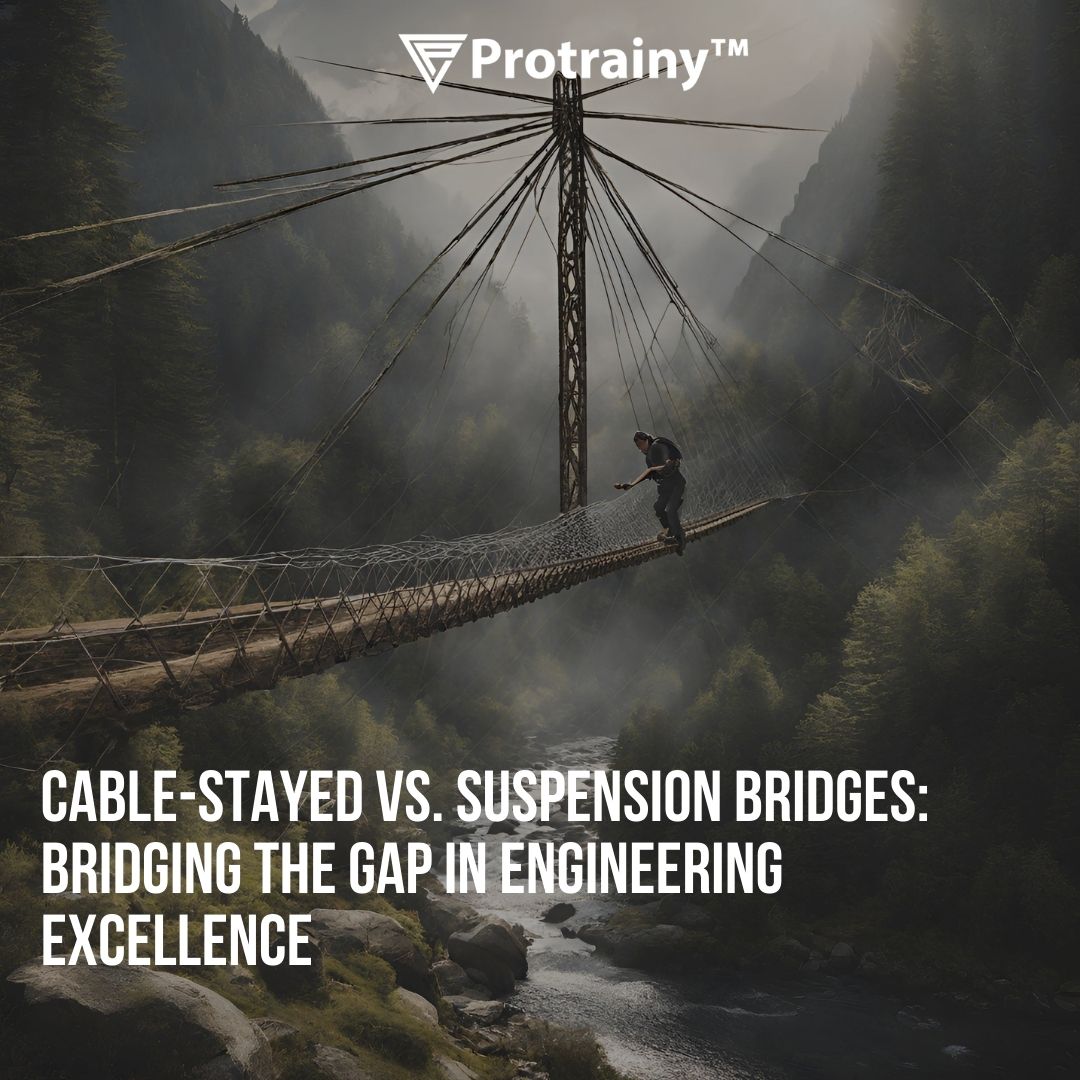Blogs
- Home
- Blogs
Cable-Stayed vs. Suspension Bridges: Bridging the Gap in Engineering Excellence
Protrainy | Sept. 2, 2023, 1:05 p.m.

Introduction:
Bridges are marvels of engineering that connect communities, facilitate trade, and defy natural barriers. Among the various bridge types, cable-stayed and suspension bridges stand out as iconic examples of human ingenuity. In this blog, we embark on a journey of exploration and comparison between these two engineering marvels, shedding light on their real-world applications, structural intricacies, and the unique advantages they bring to the world of civil engineering. Bridges are symbolic structures that span physical divides, connecting people, cultures, and economies. They come in various forms, each designed to address specific challenges posed by geography, span, and purpose. Two prominent types are cable-stayed and suspension bridges, each with its own set of characteristics and advantages.
1. Cable-Stayed Bridges Unveiled: A Symphony of Cables and Towers
Cable-stayed bridges are characterized by their towering pylons, from which cables extend to support the bridge deck. These cables are typically arranged in a fan-like or harp-like pattern, distributing the load evenly. The result is a visually striking bridge known for its aesthetic appeal and versatility.
2. Suspension Bridges: The Elegance of Hanging Roadways
Suspension bridges, on the other hand, feature massive main cables suspended from tall towers. These cables bear the weight of the bridge deck, creating a floating appearance. Suspension bridges are renowned for their long spans and graceful, sweeping curves.
3. Structural Strength: A Battle of Tension and Compression
The primary difference between cable-stayed and suspension bridges lies in their structural principles. Cable-stayed bridges rely on a combination of tension in the cables and compression in the towers to support the bridge deck. In contrast, suspension bridges rely primarily on the tensile strength of the main cables.
4. Span Length: Pushing the Limits
Suspension bridges have historically held the record for the longest spans. Iconic examples include the Akashi Kaikyō Bridge in Japan and the Golden Gate Bridge in the United States. However, cable-stayed bridges are not far behind and have made significant advancements in recent years.
5. Aesthetics and Visibility: Towers vs. Cables
Cable-stayed bridges are renowned for their dramatic and often futuristic designs, with towers that showcase architectural creativity. Suspension bridges, on the other hand, create a sense of openness and minimalism due to their slender main cables.
6. Maintenance and Accessibility: Practical Considerations
Cable-stayed bridges are often favored for their ease of maintenance. The cables are accessible and can be individually inspected and replaced as needed. In suspension bridges, accessing the main cables can be more challenging, requiring specialized equipment.
7. Case Study: Millau Viaduct vs. Akashi Kaikyō Bridge
The Millau Viaduct in France is a remarkable example of a cable-stayed bridge. Its elegant, slender towers support the road deck, creating a harmonious blend of engineering and aesthetics. On the other hand, the Akashi Kaikyō Bridge in Japan is an iconic suspension bridge known for its record-breaking central span of 1,991 meters (6,532 feet).
Impact and Beyond: Connecting the World
The impact of cable-stayed and suspension bridges extends beyond their immediate functionality. These structures connect communities, facilitate trade, and become landmarks that define cities and regions. Their unique designs and engineering excellence inspire awe and appreciation for human achievement.
Conclusion: A Tale of Two Bridges
Cable-stayed and suspension bridges represent the epitome of engineering innovation and artistic expression. While they differ in structural principles, each type of bridge excels in its own right, pushing the boundaries of span length, architectural design, and functionality. As we look to the future of civil engineering, these bridges serve as testaments to our ability to conquer geographical challenges and connect societies. In the end, whether cable-stayed or suspension, these bridges are not just links between two points; they are symbols of our ambition, creativity, and the human desire to transcend physical barriers, both seen and unseen.
